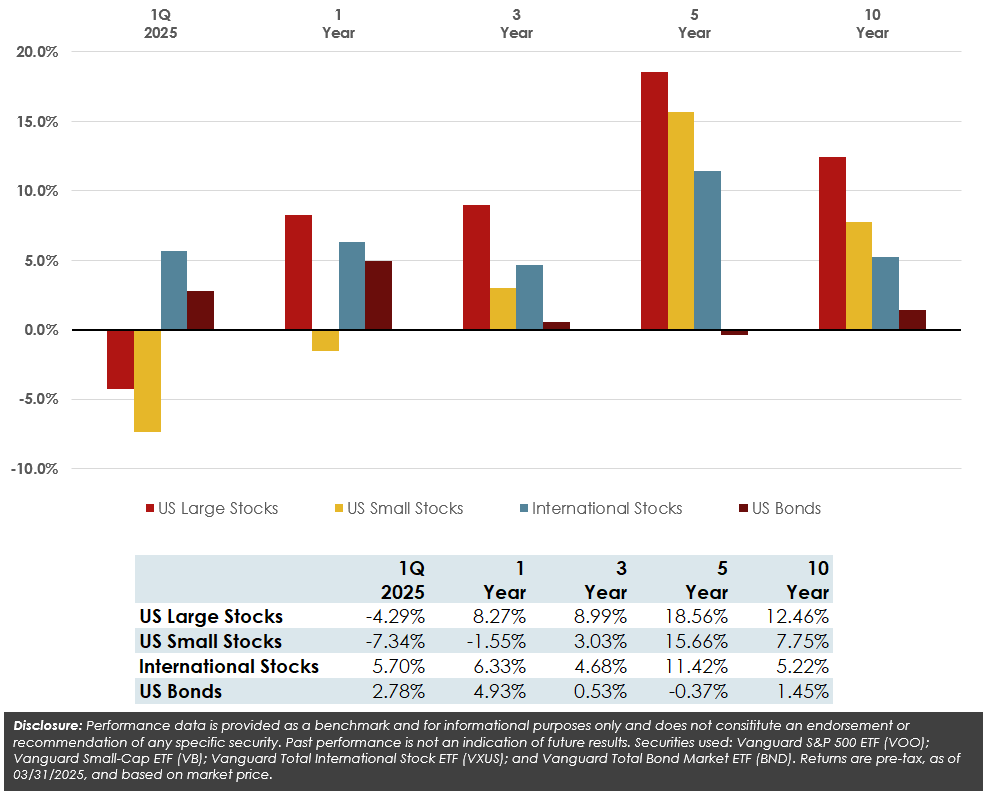Market Update

Buckle up, the ride is getting rough! The US stock market was buffeted by policy updates out of DC during the 1st quarter. Tariffs represent the primary concern. Overall, the policy strategy and goals seem chaotic and poorly communicated. It remains to be seen whether the tariffs will provide long-term benefits to the US economy and the middle class. Tariffs could indeed induce re-shoring of manufacturing jobs, but any large scale changes will take years if not decades. It’s nigh impossible to unwind globalism overnight.
International stocks resoundingly outperformed US stocks in the first quarter. Is this a start of a new trend where international stocks catch up to the blazing performance of US stocks over the past 10-15 years? It’s hard to say. However, all else equal, capital will generally flow to where it is most welcome. Broad based tariffs could have the effect of driving capital away from US markets and towards the rest of the world. Valuations also continue to favor the go-forward performance of international stocks vs US stocks.
It’s important to remember that there will ALWAYS be something to scare investors. If investing were easy or without risk, then the potential returns would be minimal. As long-term investors, we must avoid the urge to look down at our feet (i.e. the next 3-6 months), and instead lift our heads and look toward the horizon (i.e. the next 5, 10, or 20 years). Nothing in life is guaranteed, but I believe that our best hope for investing success is to ignore the noise and stick with your plan for the long-term.
Economic Update
Here are the major points of interest in the economy right now:
- The risks of a recession have increased steadily over the past 3 months. Goldman Sachs currently sees a 35% chance of recession in the next 12 months.
- The Atlanta Fed is estimating 1Q GDP growth at -2.8%. In February, this same forecast method was predicting +3.0% growth, so the change over 60 days is stark.
- Labor markets are showing some minimal signs of weakness. The federal government is shedding jobs directly as well as inducing hiring freezes at various institutions such as universities and hospitals. Stepped up immigration enforcement could also impact the availability of labor in certain industries (agriculture, construction, etc.). However, at this point the labor market data are still holding up fairly well so we’ll have to wait and see.
- The Federal Reserve has so far refused to lower interest rates under pressure from the current administration. Inflation remains close to 3%, but the Fed Board is still concerned about a resurgence in inflation if rates come down too fast.
- Broad based tariffs remain a significant wild card. Most economists assert that if tariffs are short-lived, then any economic effects will be muted. However, if tariffs are persistent, or continue to spread across the globe, then it’s likely that global economic growth will suffer.
- The chaotic nature of the tariff implementation could also diminish the economy’s “animal spirits” as people become unnerved about consumer purchases. The reality is a large component of economic health is hard to assess with data and is more subject to the spontaneous optimism/pessimism of billions of people.
- Housing prices continue to hold up well overall. Locations with large amounts of new supply coming to market have seen moderate reductions in prices and rents.
Tax/Planning Update
Large scale tax legislation is likely to come in the next few months. Many of the personal provisions from the TCJA will likely be extended. The administration and members of Congress have also put forth ideas such as no tax on tips or overtime, an increase in the state and local tax (SALT) deduction, and the ability to deduct interest on car loans. It will be interesting to see how Congress figures out a way to pay for these additional tax provisions.
Absent congressional action, the enhanced premium tax credits under the ACA will expire after 2025. If you have ACA coverage, it’s a good idea to keep an eye on developments here. The ACA tax credits had a fairly severe “tax cliff” prior to the enhancement and if we revert to the old system, then it will be important to plan ahead for that.
Super Catch Up Contributions
If you participate in a qualified retirement plan (i.e. 401(k), 403(b), and government 457) and are between the ages of 60-63, then 2025 offers the first opportunity for “super” catch-up contributions. If the plan allows it, qualifying participants can contribute up to $11,250 as a catch-up contribution. The “normal” catch-up amount of $7,500 still applies to participants aged 50-59 or 64+.
Your eligibility is determined based on the age you turn during the year. So if you turn 60-63 during 2025, you’re good. But if you turn 64, even on 12/31/2025, then you are not eligible.
There are separate rules for SIMPLE IRAs, but I’m not going to cover them here as SIMPLE IRAs are fairly rare and the rules are stupidly complicated.

